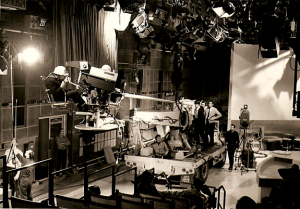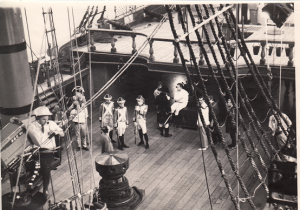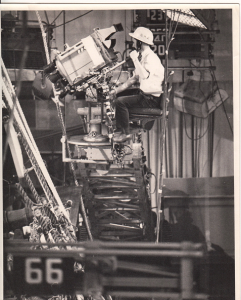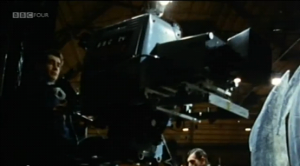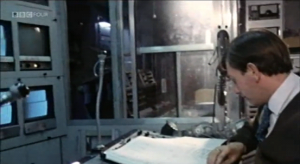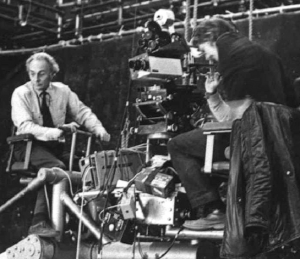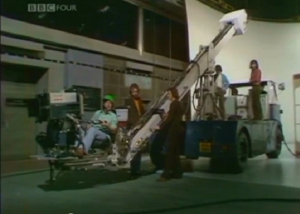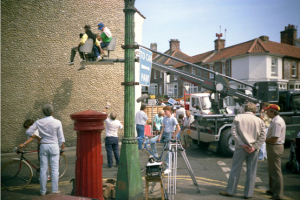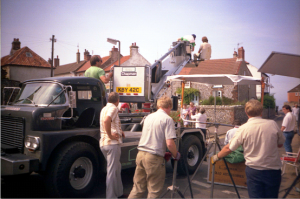Background
The Chapman Hercules Mobile Crane was developed between the years of 1953-54. This crane was able to drive to the location, and had six wheel crabbing abilities and a levelling system. In the TV Studios, the swing arm was operated by BBC Tech Ops with a hired-in driver.
The Transatlantic was a similar sized crane, but had a lattice jib/ arm, with the steering on front and back operated by BBC Tech Ops, and with a hired-in driver..
Chapman Hercules
Tony Crake
Here is [a sneaky photo] from the late 1960’s early 1970’s (Colour camera)
The cameraman was John Cavacuiti; Mike Gardener is the guy with specs on the weight and Derek Askew standing on the floor.
Not sure on the other two on the platform… the driver came with the Chapman and had just come from a shoot on “Half a Sixpence” with Tommy Steel! It was some “Play for the Day” job all about high intrigue in Television! I was playing myself as an S.A. rigging personal mics in the TV Studio Set on the right (but I never made the final cut!) Pretty sure this was when I was on Crew 2 so most likely 1966-1967
Alec Bray
The “Country and Western Show” was a one series summer version of the “Black and White Minstrel Show” with the George Mitchell Minstrels.
I got assigned to just one show as a dolly operator for the “creeper” – this was a dexion affair with castors, the pan and tilt head mounted on the floor of the dolly, so the camera was able to get very very low shots.
There was also a Chapman Hercules – the driver had an argument with the studio fire offices when he arrived, as the fire officer said that the Hercules driver was only allowed one pint of fuel in his tank (for the “road” engine) and the driver said he had to have a relatively full tank so he could drive the crane home after the show.
The floor plan showed that the creeper had to track in front of the Hercules – as the Hercules tracked back, we tracked in and vice versa. Now I tell you that the director was Stewart Morris (who figures elsewhere on the Tech Ops web site). By the time we came to Transmission, we had never completed the stagger through (after 2 days in the studio)!! So for the last part of the show we were in fear and trepidation in case the Hercules tracked forward and ran us over!
The story that went the rounds when I was working at the Beeb was that the Chapman Hercules was the crane used to film the chariot race in “Ben Hur”. The story told the tale that one of the swingers fell off during the filming and that his scream was left on the sound track.
We certainly did not want our screams on the Country and Western show!
John Howell
I seem to remember one being hired in complete with driver for a Country & Western show with Shani Wallis in TC3 or 4. On one occasion a fast pull back ended prematurely when the crane backed into the studio wall.
Pat Heigham
Shani Wallis had one of those hip flask sized radio mic TX’s strapped to her thigh. . Just before her spot, I realised that she wasn’t switched on – we had to conserve battery power.
Whizzing onto the set, I gasped: “You’re not switched on!”
A real trooper – up with the skirt, me diving underneath and groping (for the switch!).
A wonderful experience of shapely female underpinnings for a 19 year old!
Think it was TC4. The Country and Western Show was the summer replacement for the Black and White Minstrels – mostly shot in TVT, but a few shows from TC4.
Malcolm Johnson
Another use of the enormous Chapman Hercules was on an episode of a series of major dramas for the start of BBC Two called “The Seekers”.
This was a trilogy of plays that examined persecution through the ages and the episode that was shot in TC1 with the Hercules featured the whole of the studio as a compound in a second world war concentration camp.
On the final day of recording a major area of the floor had upturned turf laid which was then sprayed with water to turn it into an absolute quagmire to simulate outdoor winter conditions. You can imagine the mess!
The Hercules tracked the length of TC1 using its boom arm to the full extent. The whole crane weighed in at 11 tons which was right on the studio floor loading limit. The dolly was powered off the DC supply in the studio unlike when it was working outdoors when it ran on its diesel engine.
To add to the whole drama of the day we mounted a short arm sound boom on the crane just behind the cameraman and assistant. It was a simple film type arm with no swivel or tilt mic cradle so we had to pre-set the mic angles prior to each shot.
Keith Warren was the boom op. and after the first rehearsal when the crane came down to ground level he was as white as a sheet having been craned up to the underside to the skied lighting barrels. For the next rehearsal he wore a safety helmet!!
I can’t remember names but one of the camera assistants who were swinging the arm on the dolly got thrown off at one stage and was sent home with a twisted ankle.
The final memory of that production was learning that some days later it was discovered that the plastic sheeting that was laid under the turf had leaked water onto the studio floor which resulted in large areas having to be re-laid at great expense! A fine example of pre BBC 2 launch programme-making when the “fun factory” was working at full tilt.
Dave Mundy
The Hercules was used on the fabulous big band programme called “Best of both Worlds”. This was recorded on a Sunday and if the sound crew on ‘Grandstand’ were doing “Best of both Worlds” as well we used to nip up from Lime Grove to TC1 and do a pre-rig.
I remember the Henry Mancini shows as Hugh Barker used 35 powered mics. This was long before phantom power so we had to organise 35 mains outlets and enough mic points where the band would be. The band had 3 bass flutes in one item!
My job was to fit the hip-flask sized radio mic + BK6 to the star conductor e.g. Nelson Riddle, Henry Mancini, David Rose, Mantovani and so on. Great music!
PS. the Hercules driver was rumoured to have been done for speeding on the North Circular!
Derek Martin
I also remember the Hercules being used in TC1 – on a series of big band shows produced by Yvonne Littlewood. The driver’s name, I think, was Alan Blowey and I remember his tales of Lawrence, too.
I seem to remember swinging the arm with Chris Eames – probably with John Lintern, crew 11, on the front
Alec Bray
I worked on a programme called “Best of both Worlds”. produced by Yvonne Littlewood – although at the time that I worked on it, we just had two normal cranes (not Hercules!) tracking down each side of the band. The set comprised a couple of arches, as I recall.
Alasdair Lawrance
I remember the Chapman Hercules being in TC, and the Driver/ Tracker talking about “Lawrence’ of Arabia” and the tracking shots they did using the V8 engine.
I also had a feeling that it was used in “Kiss me Kate”, the show with Howard Keel that was supposed to be for the opening night of 2, but we all know what happened to that! There were double height flats in TC1, and I think that’s why it was used.
Bernie Newnham
I was Chapman panner for Brian White on “Jesus”, a Stewart Morris epic. At some point during rehearsal we crossed close to the main key, which was up on the gantry – producing the largest camera shadow in the world! More from that day here – http://tech-ops.co.uk/next/2010/08/stories-2/
Transatlantic crane
Keith Salmon
Billy Budd September1966
Geoff Fletcher
I went to look at an opera in TC1. I remember going in to have a look at the set, which was absolutely amazing to my eye. The sea was, I think, created by wide strips of foil with some sort of rotating mechanism beneath each strip to cause a wave-like motion, thus setting up realistic reflections in the cabin set and on the rigging and deck scenes. The cabin floor was black and white checks like a chess board.
The orchestra was in TC2 – and there were |(at least) two conductors …
Brian White
Billy Budd – What an epic – from someone who was there – TC1
7th and 8th September 1966, transmitted December.
I had the privilege of doing a ped (possibly Camera 3) alongside our great ambassador Ron Green. I seem to remember we had problems with the physical camera Viewfinder headroom as we were ‘tween decks’ (nautical term!). Anyway ALL DONE – 2hrs 40mins in 2 days!
Bill Jenkins
I think the crane cameraman is Keith Salmon (crew 7), for it was he who sent the photo in. Or am I missing something?
I remember the problems of the ‘between decks’ situation, I think there may have been headlights on the ped cameras as well.
Alan Machin
I was a very junior Sound Assistant in 1966. Chick Anthony was the Sound Supervisor in TC1 and Derek Miller-Timmins was with the LSO in TC2. I had no TV capable of receiving BBC2 at the time, so I went in to TVC that December to see the transmission in the basement viewing room. Benjamin Britten didn’t conduct as he was uncomfortable with the separation of singers and orchestra into two studios. He was present, mostly in TC2, but Charles Mackerras, who was more familiar with TV work, conducted with David Lloyd Jones as his assistant. The television production was such a success that John Culshaw, Head of Music Programmes from 1967, commissioned two further Britten opera recordings, Peter Grimes and Owen Wingrave, but at Britten’s insistence these were recorded as OBs at Snape Maltings.
Tony Crake
There was some huge crane in TC1 with the separate platform and fitting for a Fisher Boom. I and several others were the ‘rigging crew’ for the Mega Opera “Billy Budd”. I heard later that the Fisher was never used.. the movement of the crane not being compatible with opera vocal coverage!
Alan Machin
Benjamin Britten didn’t conduct as he was uncomfortable with the separation of singers and orchestra into two studios. He was present, mostly in TC2, but Charles Mackerras, who was more familiar with TV work, conducted with David Lloyd Jones as his assistant. The television production was such a success that John Culshaw, Head of Music Programmes from 1967, commissioned two further Britten opera recordings, Peter Grimes and Owen Wingrave, but at Britten’s insistence these were recorded as OBs at Snape Maltings.
I seem to remember Fisher booms being sent from TVC for ‘Peter Grimes’ along with one or two boom ops (including Mike Felton?) A very young Brian Large directed and Graham Haines was the Sound Supervisor. Anyone recognise the cameramen about 5 minutes into the programme?
Peter Cook
I well remember Peter Grimes at the Maltings. Having previously worked on the recording of Britten’s “Burning Fiery Furnace” at Orford Parish Church, it was great to return to Aldeburgh where we stayed. At a ‘listen through’ with Brain Large and the rest of the crew in an office at TC before the show, I hated the music, but in the atmospheric and natural surroundings of the marshes at Snape the music transformed into something which I now love, and every time I hear it I am transported back to Suffolk. The crew catchphrase from the show was ‘Mind that Door’ from when Grimes burst spectacularly through a door on the upper level of the stage. The show was also memorable for the fact that Brian was nursing a broken wrist, acquired I think from a trip during rehearsal on David Myerscough-Jones’s amazing tilting set.
It was actually the second recording of “Peter Grimes” in just over 5 years. During my induction course (October 1963) we were herded to Sadlers Wells (I think) where an OB unit was rehearsing the opera on stage, possibly in 625 for the new channel. The Maltings recording was in colour in February 1969. I have been reminded of the incomparable performance of Peter Pears for whom the part was written.
Mike Felton
Yes I was the boom op (there was only one). I had to build my own mic suspension for the “new” c451 with ck5 capsule as there was no official one available then. Aluminium strip, couple of bolts and elastic bands! The eventual manufactured version looked similar but didn’t work as well as it was too stiff !
They were magical times at Aldeburgh. I was also on “Owen Wingrave” a few years later and Jeff Booth did a fishing rod too.
Alex Thomas
The cameraman is the late Selwyn Cox.
I spent the fortnight in the “brothel” with Bessie Bainbridge, the madame, and her two “girls” Anne Pashley and Jill Gomez.
I was on Camera 4, Frank Hudson and Selwyn did the main 2 cameras. I remember that Roger Prior was also there. (He gave me a lift).
John Nottage
making a brief appearance
Peter Cook
I seem to recall from the late night bridge sessions at our self catering digs that Simon Fone was also a cameraman on “Peter Grimes”. Roger Prior and I shared a camera (either 5 or 6) which had two positions on rostra at the back of the auditorium. I had a position “A” back left and Roger had a position “B” back right. He did one rehearsal for me as I had a feverish cold one day.
Bill Jenkins
The crane looks like the front end of a Transatlantic
Howard Michaels
Looks like an Arri 16 with video assist mounted on a Moy film head!
Maurice Fleisher
It certainly looks like the Transatlantic but the studio (film sound stage?) doesn’t look like anything in TVC and I never saw two (or is it three) people on the front end of the crane, in a TV studio. There is actually a film camera (Mitchell Mickey-Mouse-type film magazines) on the other side of the video camera housing so I guess the video was just being used for external monitoring and I suppose all those boxes and cables on the platform were part of the rigging for both cameras.
As I recall the Transatlantic came with a driver and two steerers, one on each side of the crane body, front wheels steer or back wheels according to which direction you were heading (into the wall !!). I don’t believe those cranes were ever dry-hired and there wouldn’t have been enough room in most TVC studios to utilise it fully with the exception of TC1 or Studio G at the Grove.
It is certainly a geared camera head which could have been a Moy or Worrall or Mitchell.
Albert Barber
Looks to me like a film camera (Arri 35mm?) on top of a B/W video camera. Maybe some of those experiments using film with video like “The Avengers” as was made for ITV. The video was cut as a studio operation and then the film recording was matched to the video.
Peter Hider
It’s possible that the cameraman may be Philip Bonham Carter from TFS and his Asststant to the right in glasses Chris Seager
Pat Heigham
From my experience in the Film Industry, I would agree that it’s probably the Transatlantic crane, but I think the top camera is an Arri ST16mm silent. If it was the Beatles – and they were miming to playback, then an unblimped movie camera would not have been a problem for noise.
The lens turret was bevelled, to avoid the long focus lens being seen by the wide-angle one.
Also, most likely a Moy geared head – and the TV camera for a guide view? The camera operator in Film, with a geared head, would be occupied with pan and tilt, both hands, thus a separate chap to pull focus.
The Transatlantic had facilities for several seats – maybe the Director was on one.
On “Fiddler on the Roof” in Yugoslavia, the Boom Op and a mini-Fisher were mounted, so dialogue could be captured before the shot lifted away for a wide reveal.
Alex Thomas
In the early sixties, the Transatlantic would arrive with a driver called Elmer who was used to lots of takes of the same shot whilst filming and a bit bemused when doing live drama.
Geoff Fletcher
I remember him from the ”Inside ’64” epic – wore a Stetson and cowboy boots! Also it was indeed a crew of three with the crane – driver plus two swingers
Alasdair Lawrance
It does seem to be some kind of video assist/dual-shoot arrangement, and it does look as if there’s a scope there. I’m a bit mystified by the arm with the dark wrist band which doesn’t seem to belong to either the operator sitting down or the chap with the glasses.
At ILEA, the then Chief Engineer, Walter Kemp, had something to do with such a system, the idea being that you made a video tape for the UK and film for export/distribution. As I understood it, the film side was only activated when the video camera was cut up, but I never found out how they coped with the run-up time.
Derek Martin
I remember working on an experimental session in R1 with crew 12 – Bob Baxter, when Arri were demonstrating a hybrid film/video camera which could be used as a multi-camera production tool with the film camera only running when selected through the mixer. I remember Herr Arri himself being present – he spent most of his time walking around the studio asking the cameramen how it was to operate and most often getting the answer that it was b****y awkward. His standard response was to exclaim ‘…ah, zis is a snag!’ and move on.
Tony Nuttall
I seem to remember as a young SPOT with Uncle Ken M. from 16 visiting TC 4 or 6 to see the Instantaneous start Arri 35/16 mm Cameras with Video Assist being used on a series in the “Mogul” series (about an Oil company) some time 1969 or 1970.
Peter Hider
I was on a Transatlantic emulating an airship on a bombing mission over London on George Bernard Shaw’s “Heartbreak House” in 1977 which Cedric Messina directed (I use the term loosely). I had my head on the grid in TC1 when my tracking crew discovered that you can lean the central column of the crane to about 15 degrees off the vertical which they proceeded to do without telling me. One had the distinct, and terrifying, impression that the whole crane was going to topple over. I can’t remember who was on the crane with me turning the seats but I do remember how high it went, not a job for anyone with vertigo.
Geoff Fletcher
When I worked on the Transatlantic in TC1 with Reg Poulter, there were just the two of us at the sharp end. Reg operated the camera while I sat in the panner’ seat. There was another amusing incident when a mystery object kept intermittently appearing in shot low down on the left of frame when using a WA lens. It turned out to be my OOF left knee! Doh!
This was Camera 1 for two days on “Inside ’64” – a review of the year by the Panorama team in TC1 on 30 and 31 December 1964. At afternoon tea break Reg and I were left up on the Transatlantic crane all on our own in the studio. The set had a huge round black table at the centre of it, and as we were a bit peeved at missing our cuppa, Reg got the crane crew to position us just above the middle of it and then he put his foot down and left a dusty footprint on the surface for a laugh. Nobody noticed it for ages although it was very visible on our high shot – great puzzlement reigned in the gallery as to how it got there when they finally saw it. Amazingly, no one suspected us!
Derek Martin
I remember being camera panner for Frank Wilkins on the Transatlantic. The intrepid Frank used to get it left in the craned up position and climb down the latticework of the arm to get off – couldn’t be bothered with locking off and all that stuff!
John Nottage
I remember doing a “Blue Peter” – look around TC1, using a Transatlantic crane. It must have been 1967 or 1968. They sat John Noakes in the camera seat. I was one of the 2 arm swingers. We got an appearance fee (3 guineas or something?) because we were cued in vision to swing Noakes up tothe window of the gallery. It seems you couldn’t get a fee if you were just doing your normal job. When the show was repeated a bit later, I tried for a repeat fee, but without success…
David Brunt
They did a behind the scenes of TC1 item on 25 March 1968.
There was another BBC TV Centre ‘Behind The Scenes’ item on Blue Peter 4th November 1974. Featuring EMI 2001 cameras
Peter Hider
I was on a Transatlantic emulating an airship on a bombing mission over London on George Bernard Shaw’s “Heartbreak House” in 1977 which Cedric Messina directed (I use the term loosely). I had my head on the grid in TC1 when my tracking crew discovered that you can lean the central column of the crane to about 15 degrees off the vertical which they proceeded to do without telling me. One had the distinct and terrifying impression that the whole crane was going to topple over. I can’t remember who was on the crane with me turning the seats but I do remember how high it went, not a job for anyone with vertigo.
Chapman Apollo
Geoff Fletcher
This is a Chapman Apollo which we used when filming “Tales Of The Unexpected” [episode] “Skeleton In The Cupboard” in July 1987 (ITV). The photos illustrate three up front and two up front as for the Transatlantic.
The Director in the dark cap in the three up photo was Paul Annett.

